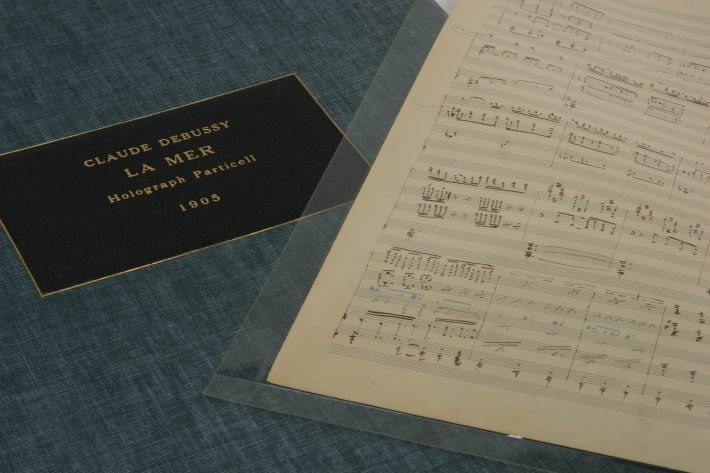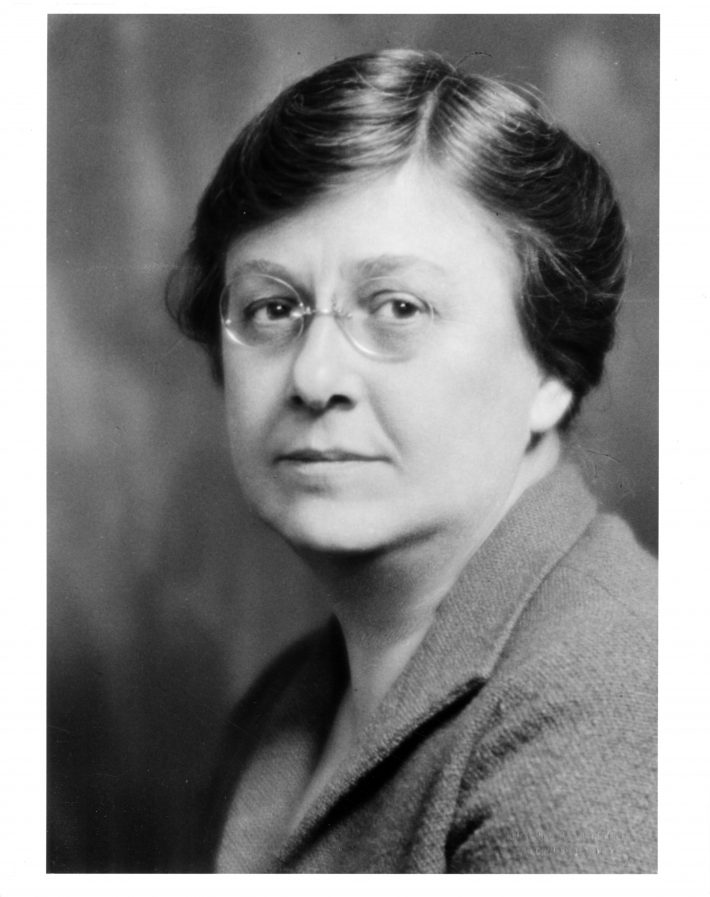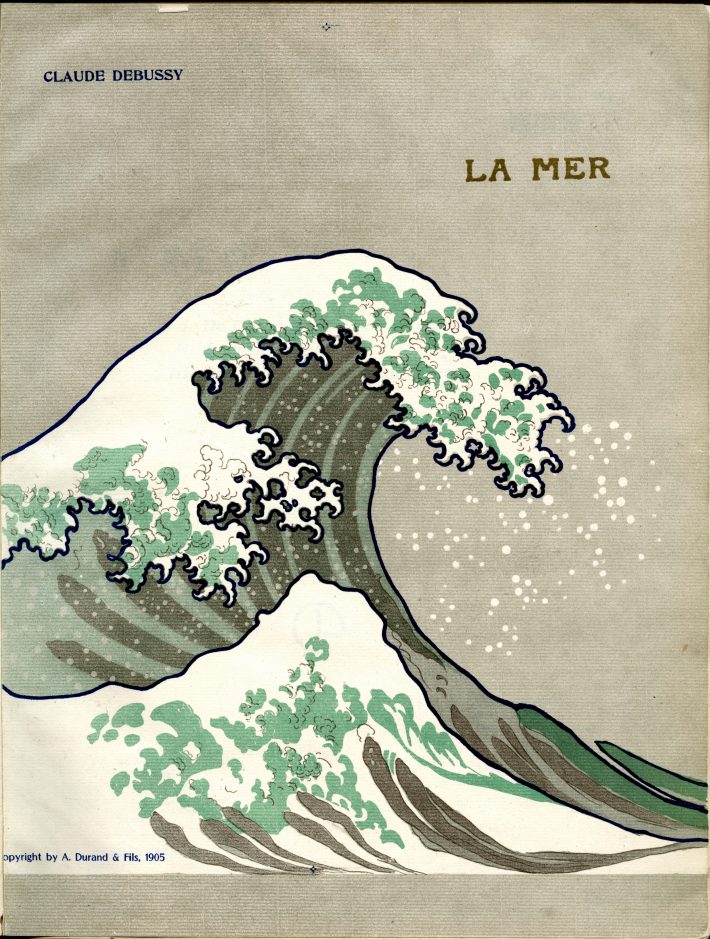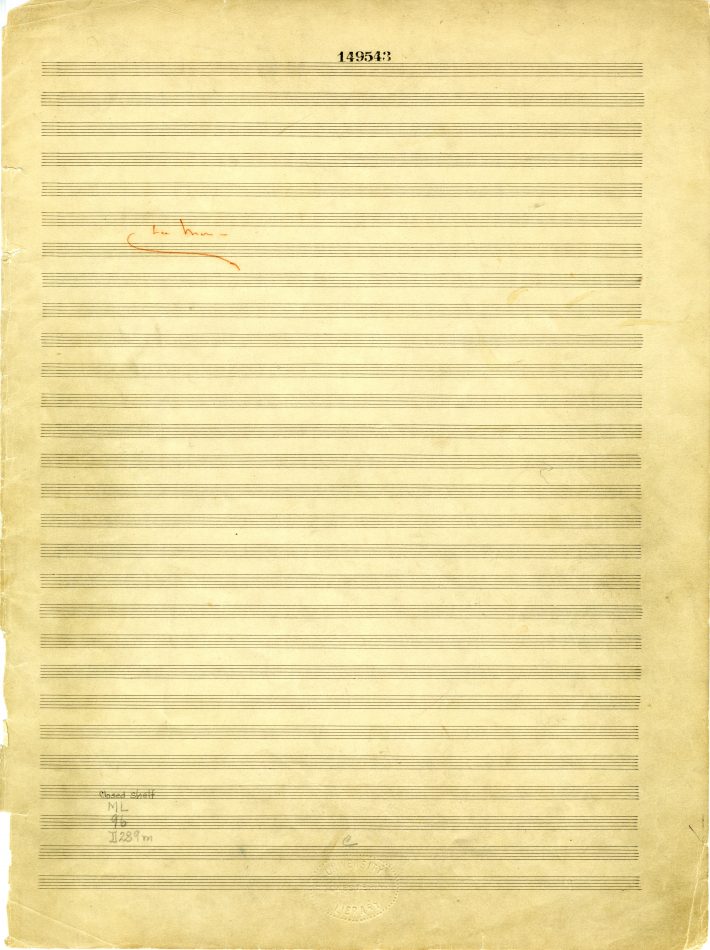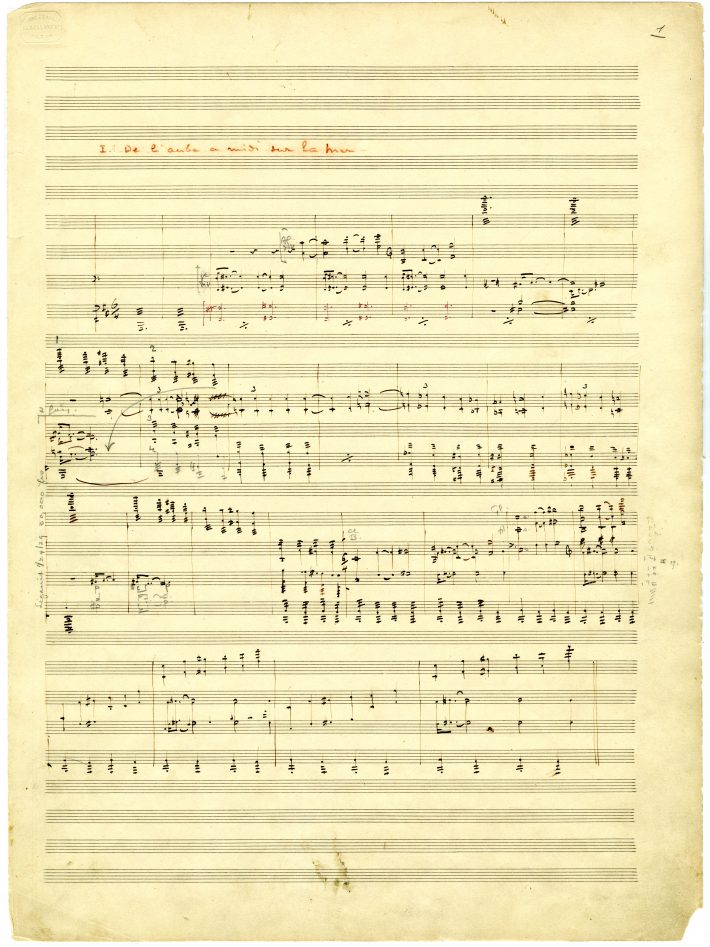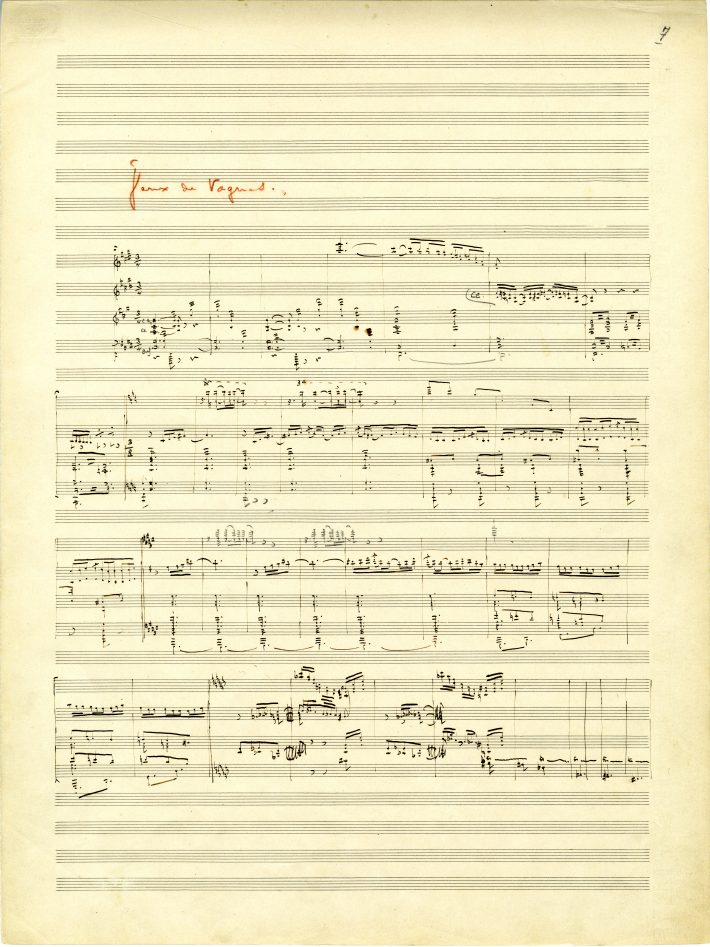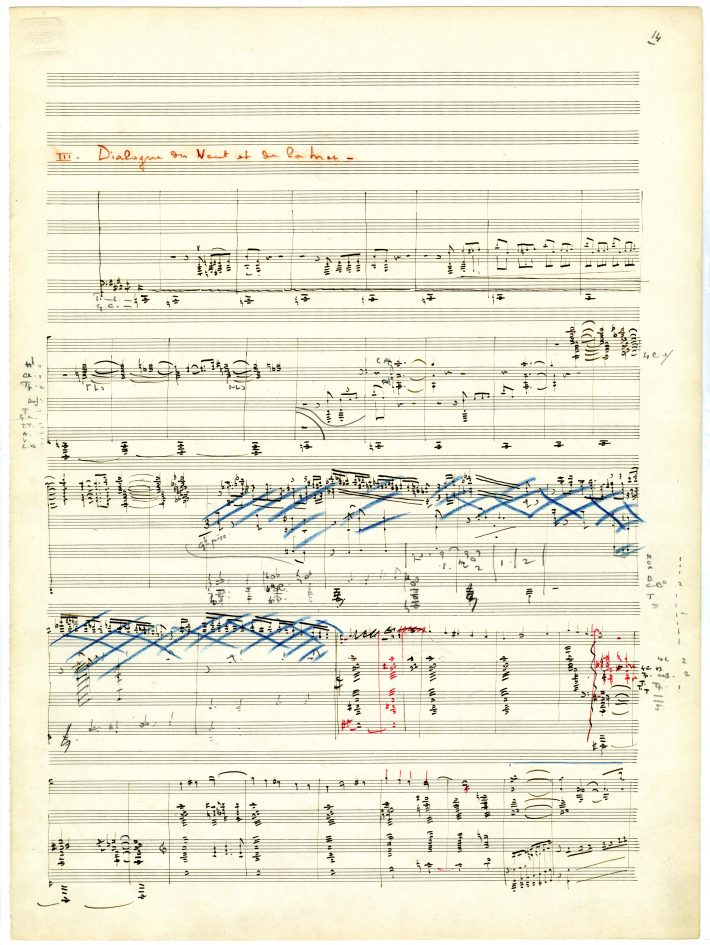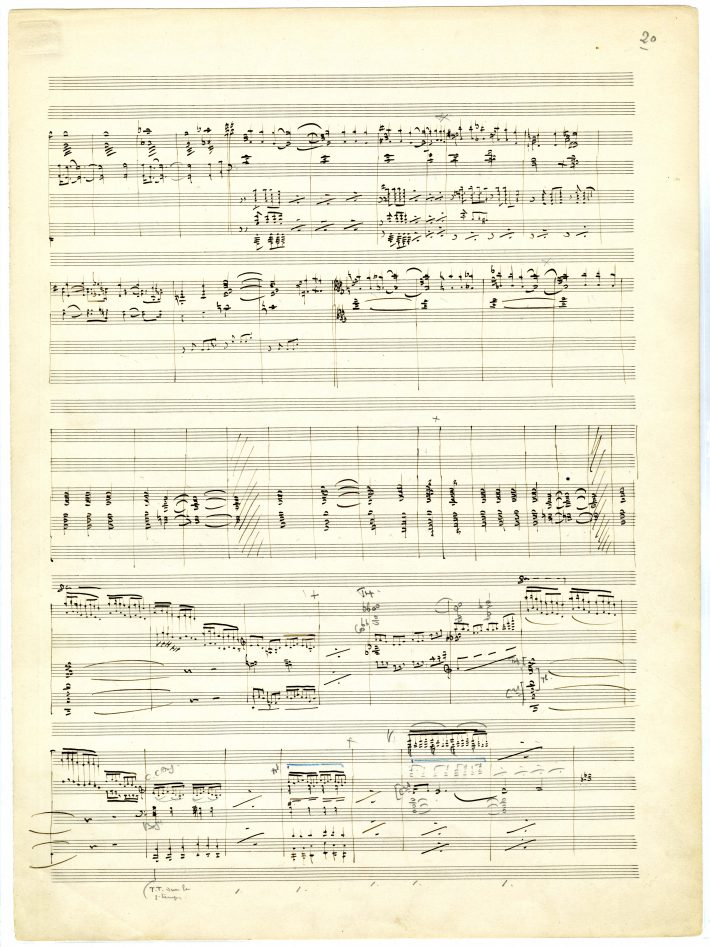Claude Debussy, La Mer
June 23, 2021Exhibit on display in the foyer of the Ruth T. Watanabe Special Collections; curated by David Peter Coppen.
Today one of the most beloved orchestral works in the literature, La Mer was composed by Claude Debussy in 1903–05 and was premiered October 15, 1905, at the Concerts Lamoureux in Paris under conductor Camille Chevillard, to whom Debussy had assigned the right of premiere performance. The US premiere took place on March 2, 1907, performed by the Boston Symphony Orchestra under conductor Karl Muck. The English premiere took place at Queen’s Hall, London, on February 1, 1908, under the direction of the composer himself. Debussy dedicated La Mer to his publisher, Jacques Durand (Paris), who brought the early editions of the work.
Three autograph manuscripts of La Mer are known to survive. Two are in the possession of the Bibliotheque Nationale (Paris), those being a fair copy of the completed orchestral score (which Debussy submitted to publisher Durand for the first printing) and a piano 4-hands transcription made by Debussy (which was also published by Durand). Since 1929, the only extant draft manuscript of the work, completed by Debussy in early 1905, has been in the possession of the Sibley Music Library.
On Display
Sibley librarian Barbara Duncan purchased the manuscript for the sum of 30,000 francs from Parisian dealer Robert Legouix, whom Miss Duncan met at auction in Berlin in June 1929. The auction was the occasion of sale, by the firms of Martin Breslauer and Leo Piepmannssohn, of the personal library of German music collector and critic Dr. Werner Wolffheim (1877–1930), whose personal collection ranked as one of the most illustrious private collections of the day. (It was at that same auction that Miss Duncan acquired what would become yet another Sibley treasure, the so-called “Rochester” Codex.) Miss Duncan briefly described the circumstance in a letter (June 6th, 1929) to University of Rochester University Librarian Donald Gilchrist, sent from Berlin:
The dealers of course are all trying to sell me all sorts of things and are being so nice to me! But don’t worry I shan’t lose my head and they can’t sell me any thing I don’t want! Another thing to talk about I have bought of Legouix (that is I told him he must first have a letter from you confirming my order) that is a real treasure. The autograph of the first draft of Debussy’s “La Mer” his most important orchestral work after the “three nocturnes” which Carl Engel bought a few years ago. It is a beautiful mss. of twenty odd folio pages signed in full and dated at the end. Debussy is an outstanding figure in music (there is no doubt of that) he is an innovator and his manuscripts are most valuable. Legouix is selling this score and another of his for the heirs. The price is 1200 dollars (I have forgotten the francs).
… Good Heavens, the Frenchman [sic] is suspicious and nervous! Everything had to be in writing. Perhaps because he was a prisoner in Germany for over three years during the war is one reason why he is so sensitive. … Because he was so edgey [sic] I thought he had better have some connection with you so that if the bill should be delayed he would be able to write directly to you.
Since then, the manuscript has been the treasured showpiece of the Sibley Music Library’s holdings—truly the jewel in the Sibley crown.
The firm of Durand et Cie. (Paris) published the first edition of the orchestral score in 1905, and subsequently brought out the second and third editions in 1909 and in 1938, respectively. As the cover illustration of the first edition, Durand used a detail from The Great Wave off Kanagawa, a woodblock print by Japanese artist Katsushika Hokusai (1760–1849). The print, published sometime between 1830 and 1833, was one image out of the series Thirty-Six Views of Mount Fuji, all of which depicted the area around Mount Fuji under specific conditions, with the mountain appearing in the background, portrayed from various angles. The artist’s choice of Mount Fuji was significant, owing to the mountain’s near-sacred status in Japan, and its recognition as a symbol of beauty and of national identity. Today the image is one of the most instantly recognized and iconic images of Japanese art from any era, and copies are held in numerous art collections around the world.
In its entirety, the print The Great Wave depicts a vast wave threatening sea-going craft near the Japanese prefecture of Kanagawa, while the stately image of Mount Fuji looms serenely in the distance and the sun shines overhead. In formatting the image to be used on the cover of the published score, publisher Durand selected essentially the left half of the print, which shows the “great wave” of the print’s title, together with a smaller wave in the foreground that, when seen in the entire print, actually reflects the image of the distant Mount Fuji (not seen on the orchestral score’s cover). Inevitably, a tension in created in the image by the viewer’s keen sense and expectation of the impending breaking of the wave.
At left, the title La mer is in the composer’s hand. Debussy used 28-stave paper to write out the manuscript, which is comprised of 21 leaves, or 21 pages of music altogether. He did not sign the title page, reserving that gesture for the last page of the manuscript. According to his own custom, he wrote only on the recto side of each leaf, which in our day has ideally enabled the Sibley Music Library’s preservation practices over the manuscript. In the 1970s, the leaves of the manuscript were encapsulated in polyester film sleeves; when the Library saw fit to commission a new encapsulation job in the year 2000, each leaf was given supportive backing of rice paper, which is non-acidic. Owing to Debussy’s practice of writing only on the recto side, the inclusion of the rice paper behind each leaf has not obscured any notation or any other writing on the verso side.
Inevitably, one notices the Sibley Music Library’s customary conventions on the title page, which are the stamped accession number (149543), indicating the manuscript’s position in the sequence of items acquired by the Library; the penciled call number; and at the bottom of the page, the institution’s embossment (UNIVERSITY LIBRARY / ROCHESTER, N.Y.). Such markings, while perhaps seeming either intrusive or else disrespectful of the artifact, i.e., the composer’s handiwork, were and are necessary gestures to signal ownership of the manuscript.
The title of the first movement—like those of the ensuing two movements—is in the composer’s hand. It has been written over an erasure, the original wording of which cannot be easily deciphered. In a letter to publisher Durand in the summer of 1903, Debussy indicated that he would call the first movement Mer belle aux Iles Sanguinaires—which happened to have been the title of a short story by Camille Mauclair that had recently appeared in Echo de Paris Illustré, which Debussy had quite likely read—but in a subsequent letter (January 6th, 1950) to Durand, Debussy indicated having changed the title to De l’aube a midi sur la mer (From dawn until noon over the sea)..
Altogether, the manuscript presents an explicit compendium of Debussy’s working habits with respect to his manuscripts; the first page demonstrates certain conventions that will recur throughout the movement. The notation is distributed among four staves, with just a few exceptions when Debussy scored specific passages on five staves. The customary marking medium for the musical text and barlines in black ink, with lead pencil used for added notes and for elaboration on details of orchestration. Debussy also uses red ink to fill in counterpoint to notation that he has already penned in black ink. With characteristic economy, Debussy dispenses with such formalities as clefs, key signature, and time signature after their initial appearance at the outset of each movement; key signatures will re-appear only when imposed by significant modulations in the music.
Debussy’s use of numbers as a shorthand device is evident in the first three bars of the second score (i.e., the second group of four staves), corresponding to bars 8-11 in the published score. The penciled numbering (1 through 4) indicates the order in which the bars should be read in light of Debussy’s evolving musical plan, which is being realized by the added notation in pencil. The musical line proceeds bar by bar according to the numbers 1 through 4; the third bar of the second score therefore corresponds to bar 12 in the published score (at which point rehearsal no. 1 appears).
Further, just as on the title page, the Sibley Music Library saw fit to enter essential information of its own, here appearing in the gutter, i.e., the margin to the left of the text (that would normally run up against the binding of a bound work). The name of the manuscript’s source, the date of accessioning, and the sum rendered were recorded for posterity.
Unlike the titles of the first and third movements, the second movement’s title, Jeux des vagues (Play of the waves), had not changed since the composer’s initial conception of the work (as made explicit by Debussy to publisher Durand by letter in the summer of 1903).
Debussy’s attention to detail is evident in his specific comments on instrumentation in the first bar, where he has indicated certain voices as being for “c.a.” (cor anglais) and for “cl.” (clarinet). His economy in writing is evident in the second score, third score, and fourth score, where he has indicated key signatures only where occasioned by outright modulations in the music.
Two other instances demonstrate the evolving state of the composition at this point in time, wherein passages sketched here would eventually appear differently in the published score. Specifically, in the 7th and 8th bars of the second score (altogether the 14th and 15th bars on the page), the arpeggiated figure on the uppermost stave eventually became a tremolo figure when played by the violas. Further, Debussy would make a rhythmic alteration in the 4th through 6th bars of the fourth score by transforming the 16th-note triplet figures into a dotted-rhythm figure played by the clarinets.
The title given to the third movement, Dialogue du vent de la mer (Dialogue of the wind and the sea), differed from what Debussy had initially planned, which was to have been Le vent fait danser la mer (The wind makes the sea dance), as he had articulated by letter (September 12th, 1903) to Durand.
The blue penciling on this page represents the most visually prominent instance of self-editing within the manuscript: the voices marked out in the third and fourth scores do not appear in the published score, thereby representing an outright excision of that musical content. Further, Debussy has added copious details of orchestration by means of pencil, both in the margins and within the staves themselves.
The composer’s customary shorthand conventions are also evident. In the fourth score, Debussy has extended a passage to something longer than initially planned by filling in with red ink to create an additional measure within the passage. To indicate repetition, he has used two different devices: a bracket (here in blue) above a stave, in the last two bars of the fifth score, indicating the content that is to be repeated; and also numbers, which he does in the third score, on the third of the four stave lines, adding two bars in pencil and marking them “1” and “2” to indicate an ensuing repetition.
On page 20, the manuscript’s penultimate page, Debussy exercises two instances of outright excision, two full measures marked out in ink in the third score. Further, he has again employed his customary notation conventions signifying repetition: brackets, in the fifth score; and symbols resembling large percentage signs, in the first, fourth, and fifth scores.
The bars that make up the entirety of the third score account for twelve bars that appear in the published score from the 5th bar after the key change (five flats) up to rehearsal no. 61, marked Très animé, where the descending 16th-note figures commence (at the beginning of the fourth score). Note that Debussy has not yet, in this manuscript, indicated the Très animé direction. Further, throughout the third score’s twelve bars of chorale-like texture that he will eventually assign to the brass, he has left unscored the very active musical lines that he will eventually assign to the woodwinds and strings in the completed orchestral score.
On the final page of the manuscript, which accounts for the last nine bars of the composition, the viewer’s attention is drawn to an all-important identifying gesture on any autograph manuscript: the composer’s signature. In this instance, Debussy has appended his signature with a statement not only of the date, but moreover, of the time of day. Marie Rolf (1976) has pointed out that the fair copy manuscript held by the Bibliothèque Nationale bears the same date, but that the weight of evidence supports the assertion that the date of March 5th, 1905, more likely pertains to the completion of the fair copy of the orchestral score, rather than this draft manuscript.
Immediately above the composer’s signature, an erasure invites curiosity. The wording that had previously been visible, and which had been erased at some unspecified point in yesteryear (presumably by Debussy himself), was discerned in 1972 by visiting conductor Pierre Boulez; subsequently it was (according to Rolf [1976]) corroborated by another native Frenchman who was on-site in Rochester. Inspection by means of microscope under infra-red light revealed the previously-appearing wording to have been the following:
pour la p.m. [petite mienne] / don’t les yeux rient dans l’ombre
(for my little one, whose eyes laugh in the background)
According to Rolf (1976), a case can be made for Emma Bardac’s having been the object of the inscription—in effect, the dedicatee of the manuscript. The composer often referred (e.g., in correspondence) to Emma as p.m. or petite mienne, and, as Rolf has suggested, the words “dans l’ombre” might have implied the secrecy of their liaison. Debussy’s relationship with Emma Bardac eventually caused a scandal in French society when his marriage to Rosalie Texier ended in divorce on August 2, 1905.
Audio Excerpt
“Fêtes,” second movement from Nocturnes [for orchestra with women’s chorus; the given movement is solely for orchestra]
Excerpt from Eastman Audio Archive call no. DM 2620
Performed by the New Eastman Symphony under Professor Brad Lubman, conductor, on January 23, 1998 in Kilbourn Hall at the Eastman School of Music. The New Eastman Symphony was a student-managed orchestra that flourished at the Eastman School in the years 1997-2000. Professor Lubman has served on the Conducting and Ensembles faculty of the Eastman School since 1996.
External Links
France Musique, “Everything you need to know about ‘La Mer’ by Debussy,’ July 2, 2018.
Exhibit curated by David Peter Coppen; this exhibit is on display in the foyer of the Ruth T. Watanabe Special Collections.

